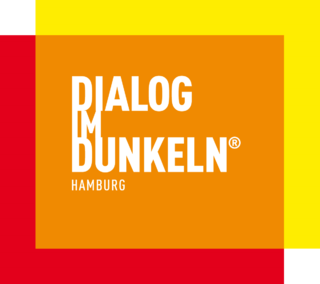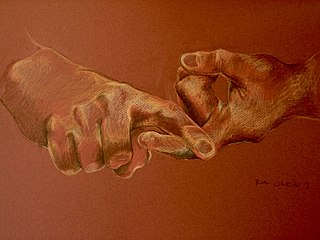This is a glossary of medical terms related to communication disorders which are psychological or medical conditions that could have the potential to affect the ways in which individuals can hear, listen, understand, speak and respond to others.
A communication disorder is any disorder that affects an individual's ability to comprehend, detect, or apply language and speech to engage in dialogue effectively with others. This also encompasses deficiencies in verbal and non-verbal communication styles. The delays and disorders can range from simple sound substitution to the inability to understand or use one's native language. This article covers subjects such as diagnosis, the DSM-IV, the DSM-V, and examples like sensory impairments, aphasia, learning disabilities, and speech disorders.
Cued speech is a visual system of communication used with and among deaf or hard-of-hearing people. It is a phonemic-based system which makes traditionally spoken languages accessible by using a small number of handshapes, known as cues, in different locations near the mouth to convey spoken language in a visual format. The National Cued Speech Association defines cued speech as "a visual mode of communication that uses hand shapes and placements in combination with the mouth movements and speech to make the phonemes of spoken language look different from each other." It adds information about the phonology of the word that is not visible on the lips. This allows people with hearing or language difficulties to visually access the fundamental properties of language. It is now used with people with a variety of language, speech, communication, and learning needs. It is not a sign language such as American Sign Language (ASL), which is a separate language from English. Cued speech is considered a communication modality but can be used as a strategy to support auditory rehabilitation, speech articulation, and literacy development.
Unconsciouscommunication is the subtle, unintentional, unconscious cues that provide information to another individual. It can be verbal l or it can be non-verbal. Some psychologists instead use the term honest signals because such cues are involuntary behaviors that often convey emotion whereas body language can be controlled. Many decisions are based on unconscious communication, which is interpreted and created in the right hemisphere of the brain. The right hemisphere is dominant in perceiving and expressing body language, facial expressions, verbal cues, and other indications that have to do with emotion but it does not exclusively deal with the unconscious.
In the United States, the Individuals with Disabilities Education Act (IDEA) is a special education law that mandates regulation for students with disabilities to protect their rights as students and the rights of their parents. The IDEA requires that all students receive a Free and Appropriate Public Education (FAPE), and that these students should be educated in the least restrictive environment (LRE). To determine what an appropriate setting is for a student, an Individualized Education Plan (IEP) team will review the student's strengths, weaknesses, and needs, and consider the educational benefits from placement in any particular educational setting. By law the team is required to include the student's parent or guardian, a general education teacher, a special education teacher, a representative of the local education agency, someone to interpret evaluation results and, if appropriate, the student. It is the IEP team's responsibility to determine what environment is the LRE for any given student with disabilities, which varies between every student. The goal of an IEP is to create the LRE for that student to learn in. For some students, mainstream inclusion in a standard classroom may be an appropriate setting whereas other students may need to be in a special education classroom full time, but many students fall somewhere within this spectrum. Students may also require supplementary aids and services to achieve educational goals while being placed in a classroom with students without disabilities, these resources are provided as needed. The LRE for a student is less of a physical location, and more of a concept to ensure that the student is receiving the services that they need to be successful.
In the United States, deaf culture was born in Connecticut in 1817 at the American School for the Deaf, when a deaf teacher from France, Laurent Clerc, was recruited by Thomas Gallaudet to help found the new institution. Under the guidance and instruction of Clerc in language and ways of living, deaf American students began to evolve their own strategies for communication and for living, which became the kernel for the development of American Deaf culture.
Singapore Sign Language, or SgSL, is the native sign language used by the deaf and hard of hearing in Singapore, developed over six decades since the setting up of the first school for the Deaf in 1954. Since Singapore's independence in 1965, the Singapore deaf community has had to adapt to many linguistic changes. Today, the local deaf community recognises Singapore Sign Language (SgSL) as a reflection of Singapore's diverse linguistic culture. SgSL is influenced by Shanghainese Sign Language (SSL), British Sign Language(BSL), Australian Sign Language(Auslan), American Sign Language (ASL), Signing Exact English (SEE-II) and locally developed signs.

Dialogue in the Dark is an awareness raising exhibition and franchise, as well as a social business. In Dialogue in the Dark, blind guides lead visitors in small groups through different settings in absolute darkness. Through this visitors learn how to interact without sight by using their other senses, as well as experience what it is like to be blind. The exhibition is organized as a social franchising company, which offers the exhibition as well as business workshops, and has created jobs for the blind, disabled, and disadvantaged worldwide. The exhibition aims to change mindsets on disability and diversity, and increase tolerance for “otherness”. More than 9 million visitors have gone through an experience in the Dark and thousands of blind guides and facilitators find employment through exhibitions and workshops.
Greek Sign Language (ENG) is a sign language used by the Greek deaf community.
Auditory-verbal therapy is a method for teaching deaf children to listen and speak using their hearing technology. Auditory-verbal therapy emphasizes listening and seeks to promote the development of the auditory brain to facilitate learning to communicate through talking. It is based on the child's use of optimally fitted hearing technology.
A dialogue journal is an ongoing written interaction between two people to exchange experiences, ideas, knowledge or reflections. It is used most often in education as a means of sustained written interaction between students and teachers at all education levels. It can be used to promote second language learning and learning in all areas.

Holon Children's Museum is a children's museum in Holon, Israel.
Prelingual deafness refers to deafness that occurs before learning speech or language. Speech and language typically begin to develop very early with infants saying their first words by age one. Therefore, prelingual deafness is considered to occur before the age of one, where a baby is either born deaf or loses hearing before the age of one. This hearing loss may occur for a variety of reasons and impacts cognitive, social, and language development.
Andreas Heinecke is a social entrepreneur and the creator of Dialogue in the Dark. He is the first Ashoka fellow for Western Europe and a Schwab Foundation for Social Entrepreneurship Global Fellow. He is also the founder of Dialogue Social Enterprise, and an honorary professor and Chair of Social Business at the EBS University of Business and Law, Wiesbaden, Germany.
Deafness has varying definitions in cultural and medical contexts. In medical contexts, the meaning of deafness is hearing loss that precludes a person from understanding spoken language, an audiological condition. In this context it is written with a lower case d. It later came to be used in a cultural context to refer to those who primarily communicate through sign language regardless of hearing ability, often capitalized as Deaf and referred to as "big D Deaf" in speech and sign. The two definitions overlap but are not identical, as hearing loss includes cases that are not severe enough to impact spoken language comprehension, while cultural Deafness includes hearing people who use sign language, such as children of deaf adults.

Christine Sun Kim is an American sound artist based in Berlin. Working predominantly in drawing, performance, and video, Kim's practice considers how sound operates in society. Musical notation, written language, American Sign Language (ASL), and the use of the body are all recurring elements in her work. Her work has been exhibited in major cultural institutions internationally, including in the Museum of Modern Art's first exhibition about sound in 2013 and the Whitney Biennial in 2019. She was named a TED Fellow in both 2013 and 2015, a Director's Fellow at MIT Media Lab in 2015, and a Ford Foundation Disability Futures Fellow in 2020.

Na Laga'at is a nonprofit organization founded in 2002 by Adina Tal and Eran Gur around the first of its kind in the world ensemble whose actors are all deafblind. The organization established a unique cultural center at the Levantbondet House in the Port of Jaffa in Tel Aviv. The center is a platform for creative arts, which promote equal and open dialogue and lead to social change built on the belief in the human spirit and its ability to reach out and make a change.
Language deprivation in deaf and hard-of-hearing children is a delay in language development that occurs when sufficient exposure to language, spoken or signed, is not provided in the first few years of a deaf or hard of hearing child's life, often called the critical or sensitive period. Early intervention, parental involvement, and other resources all work to prevent language deprivation. Children who experience limited access to language—spoken or signed—may not develop the necessary skills to successfully assimilate into the academic learning environment. There are various educational approaches for teaching deaf and hard of hearing individuals. Decisions about language instruction is dependent upon a number of factors including extent of hearing loss, availability of programs, and family dynamics.

People with extreme hearing loss may communicate through sign languages. Sign languages convey meaning through manual communication and body language instead of acoustically conveyed sound patterns. This involves the simultaneous combination of hand shapes, orientation and movement of the hands, arms or body, and facial expressions to express a speaker's thoughts. "Sign languages are based on the idea that vision is the most useful tool a deaf person has to communicate and receive information".
Deaf and hard of hearing individuals with additional disabilities are referred to as "Deaf Plus" or "Deaf+". Deaf children with one or more co-occurring disabilities could also be referred to as hearing loss plus additional disabilities or Deafness and Diversity (D.A.D.). About 40–50% of deaf children experience one or more additional disabilities, with learning disabilities, intellectual disabilities, autism spectrum disorder (ASD), and visual impairments being the four most concomitant disabilities. Approximately 7–8% of deaf children have a learning disability. Deaf plus individuals utilize various language modalities to best fit their communication needs.






